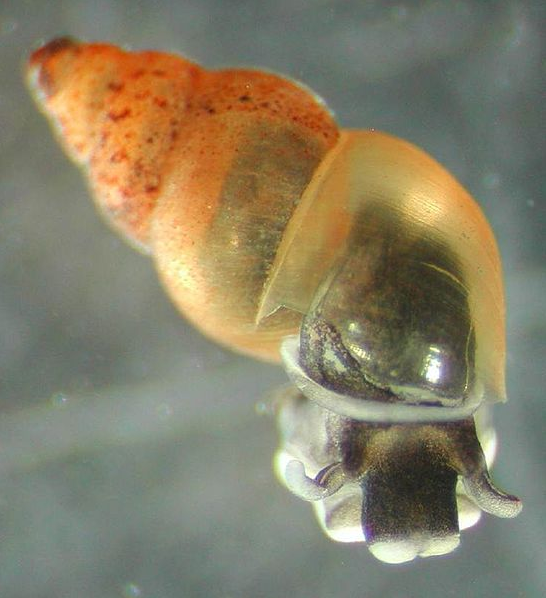Invasive species already existed near Flagg Ranch, now is in Salt River.
Mike Koshmrl
jhnewsandguide.com
Oct 24, 2018

Nonnative New Zealand mudsnails, one of which is pictured, were found this summer for the first time in the Salt River.
A slow-going mollusk native to a mountainous Pacific Ocean island has hitched a ride and found a new home in a stretch of the Snake River watershed’s southern reaches.
The invader is the New Zealand mudsnail, which until this year had not been detected in the Salt River, and its arrival isn’t being welcomed.
“There’s good news and bad news,” Wyoming Game and Fish Department aquatic invasive species specialist Chris Wight said. “The bad news is that obviously they are a classified invasive species.”
On the bright side, he said, New Zealand mudsnails are relatively ecologically innocuous, at least compared with game-changing exotics like quagga or zebra mussels.
The tiny mudsnails are already found in much of the Greater Yellowstone Ecosystem, including the Snake River near Flagg Ranch and nearby Polecat Creek. Count the Snake River’s South and Henrys forks as other undesirably occupied waters, in addition to the Madison and Yellowstone rivers.
In those places, Wight said, mudsnails boom and bust, and spread throughout river systems. The species reproduces both with mates and asexually, which means they can clone themselves. The nocturnally grazing snails are also hardy, capable of surviving the digestive systems of fish, and thus are moved from one place to the next.
“They are able to reproduce pretty rapidly,” Wight said, “but not at the exponential rate that we see with zebra and quagga mussels.”
There’s much research to be done to learn how the critters influence ecological conditions on this side of the world.
“We really haven’t done a whole lot in the eight years of the AIS program in terms of specifically looking at what these nonnative mud snails do to our native game and nongame fish,” Wight said.
One worry is that the snails can congregate at incredible concentrations and are capable of blanketing cobbles that are critical habitat for invertebrates like mayflies and caddis flies, an important food for trout. According to the U.S. Geological Survey, one study looking at populations in the Madison River found they can reach densities of over 30,000 individuals per square foot.
The Salt River isn’t the only newfound Wyoming habitat for the species.
The esteemed North Platte River fishery, near Casper, is also infected for the first time.
“New Zealand mudsnails are easily transported on waders and drift boats,” Eric Hansen, Wight’s counterpart in Game and Fish’s Casper office, said in a statement. “Not taking the time to ‘clean, drain, dry’ between waters likely led to these new infestations.”
Game and Fish sets up aquatic invasive species checkpoints around the state during the summer, but only anglers toting watercraft must stop. Shore fishermen and wade anglers must check themselves so they don’t move a species like the mudsnail from point A to B.
Wight said evidence suggests the Salt River infestation came from someone who was wading. The newly infected stretch of the Star Valley river is actually a braid of the Salt, he said, perhaps running for a 75 or 100 feet a couple miles upstream of Palisades Reservoir.
“It’s pretty consistent with the other places that we find them,” Wight said.
